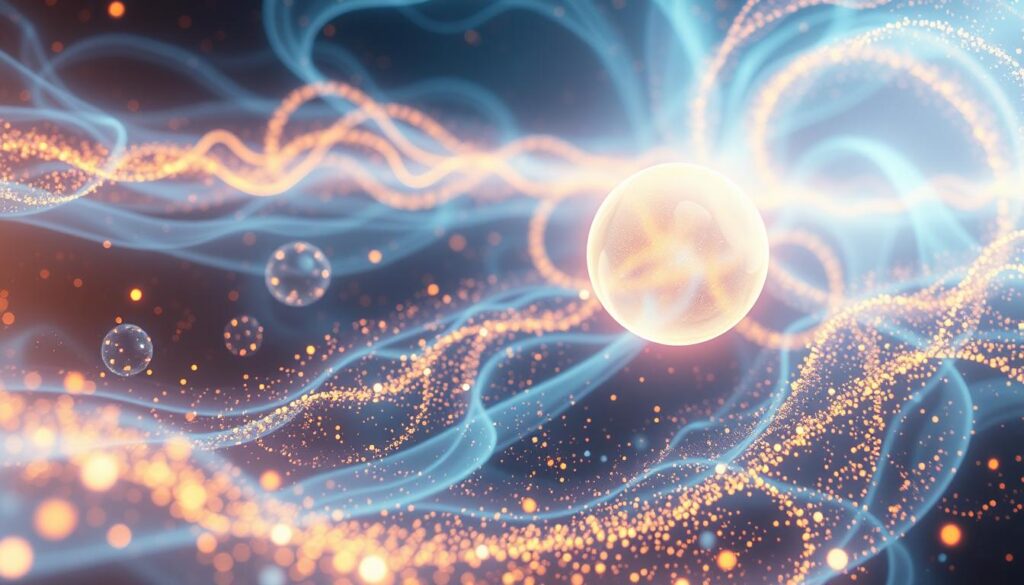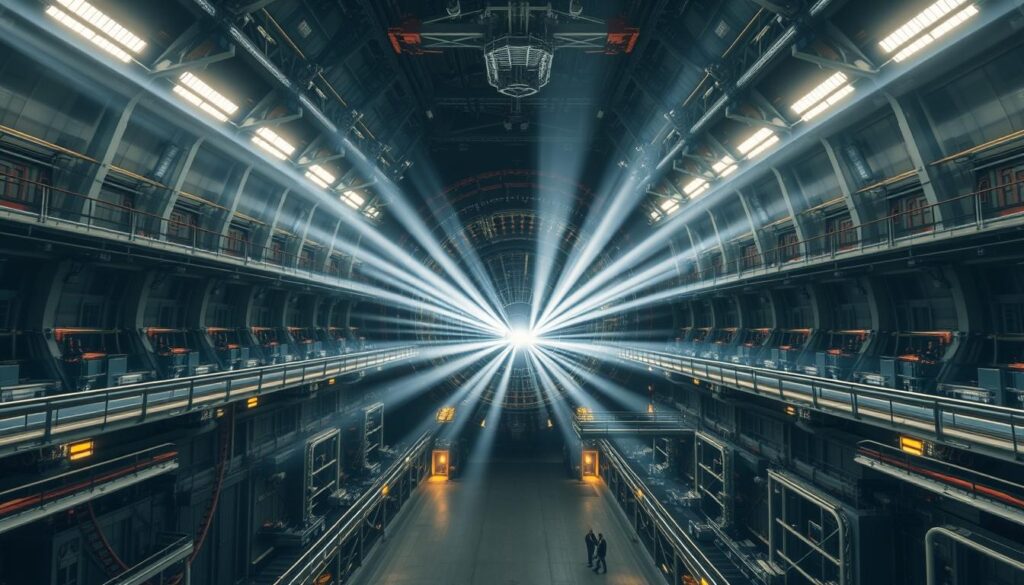
Dive into the fascinating world of particle physics and uncover the mysterious Higgs boson. This groundbreaking discovery revolutionized our understanding of how matter obtains mass. Known as the “God particle,” the Higgs boson represents a critical breakthrough in the Standard Model of particle physics.
Your journey through fundamental science begins here. Researchers at CERN spent decades hunting for this elusive particle, which plays a crucial role in explaining the basic structure of our universe. The Higgs boson helps scientists comprehend how subatomic particles acquire their fundamental properties.
When physicists finally detected the Higgs boson in 2012, they unlocked a profound scientific mystery. This discovery validated decades of theoretical work and opened new pathways for understanding the complex mechanisms that govern particle interactions at the smallest scales of existence.
The Higgs boson isn’t just another particle. It represents a fundamental building block that helps explain how energy transforms into mass. By exploring this remarkable discovery, you’ll gain insights into the intricate workings of our universe’s most fundamental components.
Understanding the Higgs Boson: The God Particle Explained

The Higgs boson represents a groundbreaking discovery in particle physics that helps explain how fundamental particles acquire mass. Often called the “God particle,” this unique quantum field theory component unlocks mysteries about the universe’s most basic building blocks.
When scientists explore the Higgs boson, they uncover a remarkable mechanism for mass generation. Imagine a field that permeates all of space, interacting with particles and giving them weight. The Higgs field does exactly that, allowing particles to move through space with different levels of resistance.
Quantum field theory suggests that particles aren’t just tiny points but complex interactions within energy fields. The Higgs boson acts like a wave in this field, demonstrating how subatomic particles gain their fundamental properties. Some particles move quickly through the Higgs field, while others interact more slowly, creating the mass variations we observe in nature.
Your understanding of this particle opens a window into the fundamental structure of our universe. Scientists worldwide continue to research the Higgs boson, seeking to unravel deeper insights into how matter and energy interact at the most microscopic levels.
The Historical Journey to Discovering the Higgs Boson

The quest to understand the Higgs boson began in the 1960s, when particle physics was on the brink of a revolutionary breakthrough. Peter Higgs and other brilliant physicists proposed a groundbreaking theory that would explain how fundamental particles acquire mass. Their work became a cornerstone of modern particle physics, sparking decades of scientific investigation.
Scientists around the world embarked on an extraordinary hunt for this elusive particle. The Higgs boson remained a theoretical concept for nearly 50 years, challenging researchers to develop increasingly sophisticated technologies to detect it. Particle physics laboratories invested tremendous resources in creating powerful experiments that could potentially reveal this mysterious subatomic particle.
The international scientific community collaborated across borders and disciplines. Researchers at CERN in Switzerland developed the Large Hadron Collider, a massive underground machine designed specifically to explore the fundamental building blocks of our universe. Their dedication represented a monumental effort to confirm Peter Higgs’ original predictions about particle interactions.
Each experimental attempt brought scientists closer to understanding the fundamental mechanisms of mass generation. The Higgs boson was not just a scientific curiosity but a critical piece in explaining how the universe structures itself at its most basic level. Particle physicists worked tirelessly, pushing the boundaries of human knowledge and technological capabilities.
Inside CERN’s Large Hadron Collider: Where Particles Meet

At the heart of particle physics research, CERN’s Large Hadron Collider stands as a marvel of scientific engineering. Located near Geneva, Switzerland, this massive scientific instrument allows researchers to explore the tiniest building blocks of our universe. The large hadron collider stretches 17 miles underground, creating a massive circular tunnel where subatomic particles race at nearly the speed of light.
Particle physics researchers use advanced technology to accelerate protons to incredible speeds before smashing them together. These controlled collisions generate immense energy, allowing scientists to observe rare particle interactions that typically occur in the first moments after the Big Bang. The complex detectors surrounding the collision points capture microscopic details of these extraordinary events.
Your understanding of the large hadron collider reveals a global scientific collaboration. Thousands of researchers from over 100 countries work together at CERN, sharing data and expertise. Each collision generates massive amounts of information, processed by powerful supercomputers that help decode the mysteries of fundamental particle interactions.
The precision of this scientific instrument is remarkable. Magnets cooled to temperatures colder than outer space guide particles through their underground journey, creating conditions that help researchers understand the fundamental laws of physics. By pushing the boundaries of current scientific knowledge, CERN continues to unlock secrets about our universe’s most fundamental components.
Peter Higgs and the Nobel Prize: A Story of Persistence

In the world of particle physics, few stories are as inspiring as that of Peter Higgs. His groundbreaking work on the Higgs boson represents a remarkable journey of scientific determination. The Scottish physicist proposed a revolutionary theory in 1964 that would take nearly five decades to prove.
Peter Higgs developed a theoretical concept explaining how fundamental particles acquire mass. His work suggested the existence of a unique field permeating the universe – now known as the Higgs field. Scientists worldwide considered his idea radical and potentially transformative for understanding particle physics.
The Nobel Prize committee recognized Higgs’s extraordinary contribution in 2013. After years of speculation, experimental confirmation at CERN’s Large Hadron Collider validated his theoretical predictions. Higgs shared the prestigious Nobel Prize in Physics with François Englert, marking a triumphant moment in scientific history.
Your understanding of fundamental physics can be deeply enriched by exploring Higgs’s journey. His persistence demonstrates how theoretical insights can reshape our comprehension of the universe, proving that patient scientific inquiry can unlock profound mysteries of existence.
How the Standard Model Fits with the Higgs Boson

The standard model of particle physics represents a groundbreaking framework that explains how fundamental particles interact and exist in our universe. Your understanding of this complex system becomes clearer when examining the Higgs boson’s critical role in completing this theoretical puzzle.
At the core of particle physics, the standard model describes twelve essential fundamental particles that form the building blocks of matter. These particles include six quarks and six leptons, which interact through four fundamental forces: strong nuclear, weak nuclear, electromagnetic, and gravitational forces.
The Higgs boson serves as a unique cornerstone in this intricate model. Its discovery validated decades of theoretical work by providing a mechanism for how particles acquire mass. Without the Higgs field, fundamental particles would remain massless and unable to form the structures we observe in our universe.
Scientists view the Higgs boson as the final piece that confirms the standard model’s predictive power. While the model successfully explains most particle interactions, researchers continue exploring potential limitations and seeking deeper insights into the fundamental nature of matter.
By understanding how the Higgs boson integrates with other fundamental particles, you gain a glimpse into the remarkable complexity of our quantum world and the sophisticated scientific framework that helps us comprehend its inner workings.
Mass Generation: The Higgs Field at Work
When you dive into the world of quantum field theory, the concept of mass generation becomes fascinating. The Higgs field plays a crucial role in explaining how particles acquire their mass. Unlike other fields in physics, the Higgs field permeates the entire universe, acting like a cosmic molasses that slows down and gives weight to fundamental particles.
Imagine particles moving through the Higgs field as swimmers moving through water. Some particles interact more strongly with this field, creating more resistance and thus gaining more mass. Lighter particles like electrons move through the field with less interaction, while heavier particles like top quarks experience significant drag, resulting in greater mass.
The mass generation process is not random. Each particle’s interaction with the Higgs field determines its mass characteristics. Massless particles can zip through the field quickly, while particles that engage more deeply become slower and heavier. This intricate dance of particle interactions reveals the complex nature of quantum field theory and how fundamental particles acquire their distinct properties.
Scientists continue to explore the nuanced mechanisms of mass generation. By studying the Higgs field, researchers gain deeper insights into the fundamental building blocks of our universe and the intricate ways particles interact and acquire mass.
From Theory to Reality: Detecting the Higgs Boson
Detecting the Higgs boson was a monumental challenge in particle physics. Scientists at CERN’s Large Hadron Collider faced an incredible task of finding an extremely rare particle that exists for mere fractions of a second. The detection process required sophisticated technology and innovative data analysis techniques.
Your understanding of this discovery begins with the complex experimental setup. Researchers used high-energy particle collisions to recreate conditions similar to the early universe. The Large Hadron Collider accelerated protons to nearly light speed, smashing them together to generate conditions where the Higgs boson might emerge.
Data analysis played a critical role in confirming the Higgs boson’s existence. Physicists sifted through massive amounts of collision data, looking for specific decay patterns that would indicate the particle’s presence. On July 4, 2012, scientists announced they had found compelling evidence of the Higgs boson, marking a significant breakthrough in particle physics.
The detection validated decades of theoretical work and provided crucial insights into how fundamental particles acquire mass. By using advanced statistical methods and cutting-edge technology, researchers transformed an abstract theoretical concept into a measurable scientific reality.
Impact on Modern Physics and Future Research
The discovery of the Higgs boson represents a pivotal moment in particle physics, opening new pathways for understanding the fundamental particles that compose our universe. Researchers at CERN have demonstrated how this breakthrough strengthens the quantum field theory, providing critical insights into mass generation and particle interactions.
Your exploration of the Higgs boson reveals profound implications for future scientific research. Advanced experiments now aim to probe deeper into the mysteries of fundamental particles, investigating potential variations or unexpected properties that might challenge existing scientific models. Scientists worldwide continue to push the boundaries of knowledge through innovative research at cutting-edge facilities.
The ongoing quest in particle physics extends beyond current understanding. Researchers are now examining potential connections between the Higgs boson and dark matter, seeking to unravel complex interactions that could revolutionize our comprehension of the universe’s fundamental structure. These investigations promise to unlock new dimensions of scientific understanding and potentially transform our perception of physical reality.
As technology advances, you can expect more sophisticated experiments that will further illuminate the intricate world of subatomic particles. The Higgs boson discovery has not only validated existing theories but also sparked unprecedented curiosity about the unknown frontiers of quantum mechanics and particle physics.



